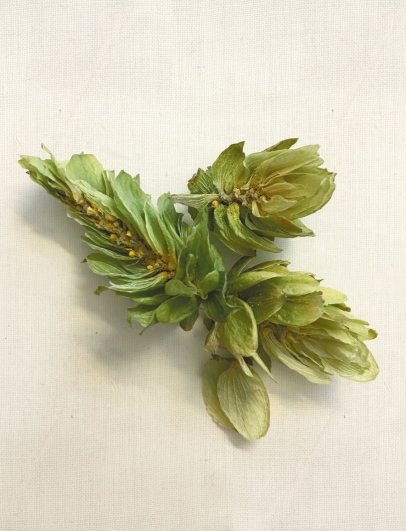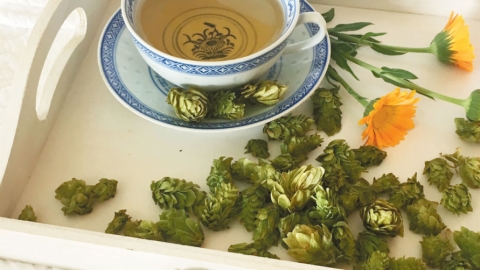Hops Fever
The curious qualities of America’s favorite craft beverage ingredient
ARE HOPS YOUR CUP OF TEA?
It’s not unusual to hear craft-beer enthusiasts get swoony over the distinct aroma characteristics of certain hops— maybe comparing the chocolate tones of one hop variety to the delicate flower essences of another. If it sounds like they are discussing fine teas … they are! Experts experience and name the aromas of each hop variety by making infusions of the hop flowers. Much like wine grapes, each hop cultivar is distinct. The hops, along with other ingredients, help create the personality of each beer. But with hop acreage growing as fast as the vigorous plants themselves, folks are tapping into new and different ways to use hops. In the last five years hop fever has caused harvest acreage in the U.S. to jump from just over 35,000 acres to almost 56,000.
HOPS’ NEXT GENERATION
The citrus highlights of hops have made them the star of a new bubbly beverage brought to you by H2OPS from California. They’ve created a sparkling water to tickle your tongue that is nothing like beer. It has no calories, no alcohol, no carbs … just light delights of hop flavor.
One future role of the hop plant may be found in its fiber potential. A member of the Cannabaceae family, hops are related to hemp, and incidentally also to marijuana. Like hemp, hop stems can be processed into nice long fibers and after the millions of hop flowers (more accurately called strobili) are harvested, the stems (called bines) can be reclaimed. While this lovely renewable resource isn’t actively being used for fiber production, it is being considered. So it isn’t unlikely that hop skirts and shirts will soon become all the rage.
Meanwhile, as hop plants are being thought about as another way to save our planet through sustainability, they are also going to the outer limits—specifically Mars. In preparation for a potential colonization of Mars, scientists are exploring what plants grow and how to grow them in space. Hops were included in Villanova University’s Red Thumb Mars Garden Project. For the experiment, students replicated a Mars-like environment in a greenhouse, and it turns out, hops did pretty well.
FROM MUGS TO PLATES
An idea as old as beermaking with hops—perhaps older—is to serve them for dinner. In fact, Romans in the days of Pliny did do that. They prepared the young shoots like we might prepare asparagus. Some modern foodies are now doing the same. You can even stuff the leaves like grape leaves. And, at the slight risk of putting your guests to sleep, you can also crumble some hop strobili on your salad. They add a zippy and bitter crunch to your greens but the lupulin, the active ingredient in hops, can have a sedative effect.
HOPS FOR HEALING
In many cultures, hops have long been associated with healing and relaxing. Some Native American cultures claimed they had a role in curing gout, ear infections, and settling digestion as well as being a sedative. Ayurvedic tradition credits hops with sedative and antibacterial action. Traditional Chinese medicine used hops for treating insomnia and intestinal disorders.
Today, hops for medicinal use can come in many forms—capsules, tinctures, oils, and simply loose dried strobili—and with many health claims. Rosemary Gladstar, author of Herbal Recipes for Vibrant Health calls hops a primary digestive sedative and nervine herb. Nervine herbs reduce stress and anxiety and directly benefit the nervous system by fortifying the nerve tissue and helping to relax the nervous system. She suggests using hops in formulas to enhance sleep and restfulness, settle digestion and ease tension and anxiety.
Hops are not recommended for people with depression as it can make symptoms worse. And as always, try your herbal remedies with moderation at first. Every body reacts differently to various plants. And even trusted herbs and plants can vary with seasons and soil so start with conservative amounts when trying herbal remedies.
Hops also have antibacterial/antimicrobial properties. This was first noticed by very early beermakers. Brewers using hops noticed their beers had a longer shelf life compared to beers made with other traditional bitter herbs such as mugwort, dandelion and yarrow. These days, in addition to being used in herbal remedies for humans, they are even being studied as a potential replacement for antibiotics in animal husbandry.
DON’T WORRY, BE HOPPY
Now you can ease your cares and woes by relaxing at a spa that offers hop products and services. Hop in the Spa in Sisters, Oregon, describes their bath created with hops, minerals and other “proprietary ingredients” as hop hydrotherapy. While you bathe you can enjoy a Bavarian pretzel and a mug of beer. Grandwellness Spa in Brantford, Ontario (just over an hour and a half drive from Buffalo), offers a therapeutic bath, a Healing “Ale”ments Scrub and a Body Brew Wrap.
HOP SPA DIY
You can fill your own tub with brew or you can take a simpler approach and craft your own bath blends, teas and dream pillows to help you relax and be happy at home. Start by finding a type of hop with aromas you appreciate (chocolate, flower essences, citrus) then add complementary herbs that you enjoy.
For a bath blend try combining rose petals and skin smoothers such as eucalyptus and calendula petals. Epsom salts, rich in magnesium, are a nice addition and you can use your blends as a full bath or footbath. For teas, lemon balm is a calming and tasty companion to hops. Herbalists sometimes recommend adding valerian and/ or chamomile, both sleep aids, if you are trying to fight insomnia. You may want to work with an herbalist to create a special blend to achieve a particular goal.
Dream pillows, also called comfort pillows, have been tucked under people’s heads for centuries to promote sleep, ward off bad dreams or evil spirits and even as love potions. They are small pillows filled with a couple of tablespoons of an aromatic herbal blend. Elaborately decorated or a simple drawstring muslin bag, dream pillows often include hops in the mix for their sedating properties. Other popular herbs for dream pillows include chamomile, catnip, sweet marjoram and lavender. You can even use a clean sock as a dream pillow! When it’s time for bed, you just place your dream pillow inside your regular pillow and breathe deeply.
FIND YOUR HOPS
You can buy hop tea or dried hops from various places but for many reasons you might want to buy your hops locally. Many tea or dried herb companies can’t tell you the cultivar of hops that they use and cultivars vary widely in how they smell and taste. And you have no idea when or how they were dried and how long they sat on a shelf. Some dried hops have been sulfured to help preserve them and you don’t want to use those for bathing or medicinal use.
With mishandling, hops can lose their effectiveness quite quickly. Like any herb, if a hop strobilus is dried gently and stored correctly away from the light, it can retain its herbal magic longer. The optimum time from the field to the drying racks is very short—even after half an hour the strobili can start to degrade. Many brewers dry their own hops and store them in the freezer until ready for use ensuring that the aromas and lupulins retain maximum freshness. Hop flavor, aroma and effectiveness can also be influenced by when the hop was picked. Too early or too late can impact its aroma.
So, lucky local you. If you know your farmer you can see how things are done. And you can try different cultivars to see which one suits your fancy.
Many hop yards are easy to find as they paint a dramatic profile on the horizon with their spiraling spires. But if you don’t see any on your daily commute you can consult the Northeast Hops Alliance online. Not all growers are listed because they may not have become members so you still might have to keep your eyes peeled.
You can even grow your own. Growing from seed is unpredictable so your best bet is to get a cutting from a trusted source. A wide variety of plants is available at Great Lakes Hops in Michigan and they do a great job of explaining each plant’s attributes.
Mid-August to early September is harvest time, and some places, like Genesee Country Village in Mumford, NY, let you join in the harvest fun. You are likely to have a good night’s sleep after a long day working outside with the added benefit of taking in all that soporific lupulin scent and pollen. You also are likely to have sticky hands.
WHICH BREW FOR YOU?
Using the aroma charts and descriptions provided for brewers will guide you to the best hops for baths and teas. As an example, the Cascade cultivar is described by one hop supplier as having shades of blackberry, toffee, lychee, citrus and strawberry. It is less bitter than some others. Chinook, which might be used for heavy bodied dark ales is a “super alpha” according to Great Lakes Hops. It has characteristics of fennel, basil, elderberry and lychee and is not particularly recommended for tea.
Full leaf sweet hops that are low in alpha acids (the part that provides bitterness) and high in beta acids (the part that gives it antibacterial qualities) are typically better for teas and medicinal blends. Tettnanger, with aromas of lily-of-the-valley, floral black tea, gingerbread and chocolate, has been recommended for tea due to its nice aroma quality and low acids. A newer hybrid called Teamaker has nice floral aromas and virtually no bitterness, yet it contains high levels of beta acids. For this reason, Great Lakes Hops lists it as “a unique hop useful for antimicrobial organic herbal teas and compounds.” Ask your local farmer to tell you the characteristics of their hops, or find various hop aroma charts online.
HOPS TRIVIA: BINES? NOT VINES?
Bines are strong flexible plant stems that bind themselves to a support. Stiff hairs on the stem help them hold on. The stem of a hop is a bine. So are the stems of runner beans and honeysuckle. Bines always twist in one direction: hops go clockwise, runner beans go counterclockwise. In case you are wondering, that is true even south of the equator.
A vine, on the other hand, uses tendrils to grip onto support structures. Grapes are an easily recognized vine.








